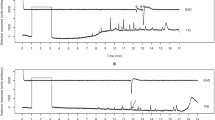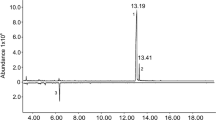Abstract
Topical application of the juvenile hormone analog, fenoxycarb, in acetone induced newly emerged male California five-spined ips,Ips paraconfusus Lanier, to become attractive to females, as measured by positive responses to male abdominal extracts in a laboratory bioassay. Two pheromones, ipsdienol and ipsenol, were detected by gas chromatography in the abdominal extracts of fenoxycarb-treated males. Pheromone production was minimal at a dose of 0.1 μg/insect of fenoxycarb, maximal at 10 μg, and was reduced to unmeasurable amounts at a dose of 100 μg. In comparison, peak production of pheromones was induced at a dose of 0.1 μg/insect of natural juvenile hormone (JH III). Treatment with 10 μg of fenoxycarb resulted in the occurrence of pheromones 12 hr after exposure, maximal pheromone content between 16 and 20 hr, and undetectable amounts after 36 hr. The demonstration that fenoxycarb is an active juvenile hormone analog for a bark beetle suggests that it may have practical utility in managing these insects.
Similar content being viewed by others
References
Anonymous. 1983, Ro 13-5223. Technical data sheet. Dr. R. Maag Ltd., CH-8157. Maag Technical Bulletin, Dielsdorf, Switzerland.
Bell, W.J., andBarth, R.H., Jr. 1970. Quantitative effects of juvenile hormone on reproduction in the cockroachByrsotria fumigata.J. Insect Physiol. 16:2303–2313.
Borden, J.H. 1967. Factors influencing the response ofIps confusus (Coleoptera: Scolytidae) to male attractant.Can. Entomol. 99:1164–1193.
Borden, J.H. 1982. Aggregation pheromones, pp. 74–139,in J.B. Mitton and K.B. Sturgeon (eds.). Bark Beetles in North American Conifers: Ecology and Evolution. University of Texas Press, Austin.
Borden, J.H. 1985. Aggregation pheromones, pp. 275–285,in G.A. Kerkut and L.I. Gilbert (eds.). Comprehensive Insect Physiology, Biochemistry and Pharmacology, Vol. IX. Pergamon, Oxford.
Borden, J.H., Nair, K.K., andSlater, C.E. 1969. Synthetic juvenile hormone: Induction of sex pheromone production inIps confusus.Science 166:1626–1627.
Bridges, J.R. 1982. Effects of juvenile hormone on pheromone synthesis inDendroctonus frontalis.Environ. Entomol. 11:417–420.
Byers, J.A. 1981. Pheromone biosynthesis in the bark beetle,Ips paraconfusus, during feeding or exposure to vapours of host plant precursors.Insect Biochem. 11:563–569.
Conn, J.E. 1981. Pheromone production and control mechanisms inDendroctonus ponderosae Hopkins. MSc thesis. Simon Fraser University, Burnaby, B.C., Canada.
Dorn, S., Frischkencht, M.L., Martinez, V., Zurflüh, R., andFischer, U. 1981. A novel nonneurotoxic insecticide with a broad activity spectrum.Z. Pflanzenkr. Pflanzenschutz 88:269–275.
Edwards, J.P., andShort, J.E. 1984. Evaluation of three compounds with insect juvenile hormone activity as grain protectants against insecticide-susceptible and resistant strains ofSitophilus species (Coleoptera: Curculionidae).J. Stored Prod. Res. 20:11–15.
Fockler, C.E., andBorden, J.H. 1973. Mating activity and ovariole development ofTrypodendron lineatum: Effect of a juvenile hormone analogue.Ann. Entomol. Soc. Am. 66:509–512.
Marring, C.M. 1978. Aggregation pheromones of the European fir engraver beetlesPityokteines curvidens, P. spinidens andP. vorontzovi and the role of juvenile hormone in pheromone biosynthesis.Z. Angew. Entomol. 85:281–317.
Hedin, P.A., Lindig, O.H., andWiygul, G. 1982. Enhancement of boll weevilAnthonomus grandis Boh. (Coleoptera: Curculionidae) pheromone biosynthesis with JH III.Experientia 38:375–376.
Hughes, P.R. 1975. Pheromone ofDendroctonus: origin of α-pinene oxidation products present in emergent adults.J. Insect Physiol. 21:687–691.
Hughes, P.R., andRenwick, J.A.A. 1977a. Neural and hormonal control of pheromone biosynthesis in the bark beetle,Ips paraconfusus.Physiol. Entomol. 2:117–123.
Hughes, P.R., andRenwick, J.A.A. 1977b. Hormonal and host factors stimulating pheromone synthesis in the female western pine beetle,Dendroctonus brevicomis.Physiol. Entomol. 2:289–292.
Karrer, F., andFarooq, S. 1981. Some insect growth regulators with aromatic rings: Their synthesis and biological properties, pp. 289–302,in F. Sehnal, A. Zabza, J.J. Menn, and B. Cymborowski (eds.). Regulation of Insect Development and Behaviour. Wroclaw Technical University Press, Wroclaw, Poland.
Kramer, K.J., Beeman, R.W., andHenricks, L.H. 1981. Activity of Ro 13-5223 and Ro 13-7744 against stored product insects.J. Econ. Entomol. 74:678–680.
Masner, P., Dorn, S., Vogel, W., Kalin, M., Graf, O., andGünthart, E. 1981. Types of responses of insects to a new IGR and to proven standards, pp. 808–818,in F. Sehnal, A. Zabza, J.J. Menn, and B. Cymborowski (eds.). Regulation of Insect Development and Behaviour. Wroclaw Technical University Press, Wroclaw, Poland.
Menon, M., andNair, K.K. 1972. Sex pheromone production and reproductive behaviour in gamma-irradiatedTenebrio molitor.J. Insect Physiol. 18:1323–1331.
Miller, D.R., andBorden, J.H. 1985. Life history and biology ofIps latidens (LeConte) (Coleoptera: Scolytidae).Can. Entomol. 117:859–871.
Nijhout, H.F., andWilliams, C.M. 1974. Control of moulting and metamorphosis in the tobacco hornworm,Manduca sexta (L.): Cessation of juvenile hormone secretion as a trigger for pupation.J. Exp. Biol. 61:493–501.
Parrella, M.P., Christie, G.D., andRobb, K.L. 1983. Compatibility of insect growth regulators andChrysocharis parksi (Hymenoptera: Eulophidae) for the control ofLiriomyza trifolii (Diptera: Agromyzidae).J. Econ. Entomol. 76:949–951.
Pitman, G. B., Kliefoth, R.A., andVité, J.P. 1965. Studies on the pheromone ofIps confusus (LeConte). II. Further observation on the site of production.Contrib. Boyce Thompson Inst. 23:13–18.
Reede, R.H. De, Groendijk, R.F., andWit, A.K.H. 1984. Field tests with insect growth regulators, epofenonane and fenoxycarb, in apple orchards against leafrollers and side-effects on some leafroller parasites.Entomol. Exp. Appl. 35:275–281.
Reede, R.H. De, Alkema, P., andBlommers, L.H.M. 1985. The use of the insect growth regulators fenoxycarb and epofenonane against leafrollers in integrated pest management apple orchards.Entomol. Exp. Appl. 39:265–272.
Renwick, J.A.A., Pitman, G.B., andVité, J.P. 1966. Detection of a volatile compound in hindguts of maleIps confusus (LeConte) (Coleoptera: Scolytidae).Naturwissenschaften 53:83–84.
Rountree, D.B., andBollenbacher, W.E. 1984. Juvenile hormone regulates ecdysone secretion through inhibition of PTTH release.Amer. Zool. 24:31A.
Staal, G.B. 1975. Insect growth regulators with juvenile hormone activity.Annu. Rev. Entomol. 20:417–460.
Stock, A.J., andBorden, J.H. 1983. Secondary attraction in the western balsam bark beetle,Dryocoetes confusus (Coleoptera: Scolytidae).Can. Entomol. 115:539–550.
Wood, D.L. 1961. Stridulation in the genusIps De Greer.Pan-Pacif. Entomol. 37:187–188.
Wood, D.L., andBushing, R.W. 1963. The olfactory response ofIps confusus (LeConte) (Coleoptera: Scolytidae) to the secondary attraction in the laboratory.Can. Entomol. 95:1066–1078.
Yagi, S., andFukaya, M. 1974. Juvenile hormone as a key factor regulating larval diapause of the rice stem borer,Chilo suppressalis (Lepidoptera: Pyralidae).Appl. Entomol. Zool. 9:247–255.
Zar, J.H. 1984. Biostatistical Analysis, 2nd ed. Prentice-Hall, Englewood Cliffs, New Jersey.
Author information
Authors and Affiliations
Rights and permissions
About this article
Cite this article
Chen, N.M., Borden, J.H. & Pierce, H.D. Effect of juvenile hormone analog, fenoxycarb, on pheromone production byIps paraconfusus (Coleoptera: Scolytidae). J Chem Ecol 14, 1087–1098 (1988). https://doi.org/10.1007/BF01019337
Received:
Accepted:
Issue Date:
DOI: https://doi.org/10.1007/BF01019337




